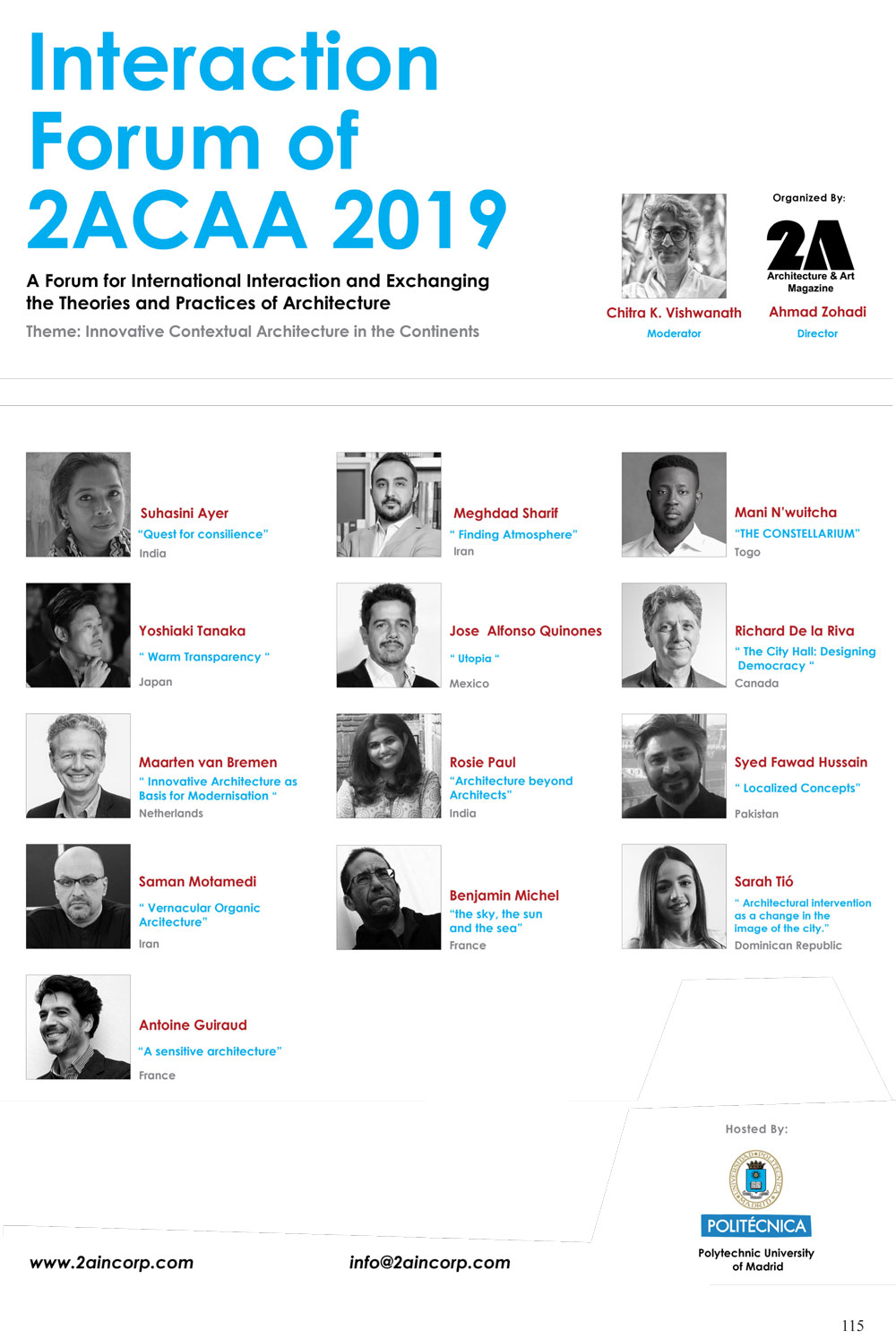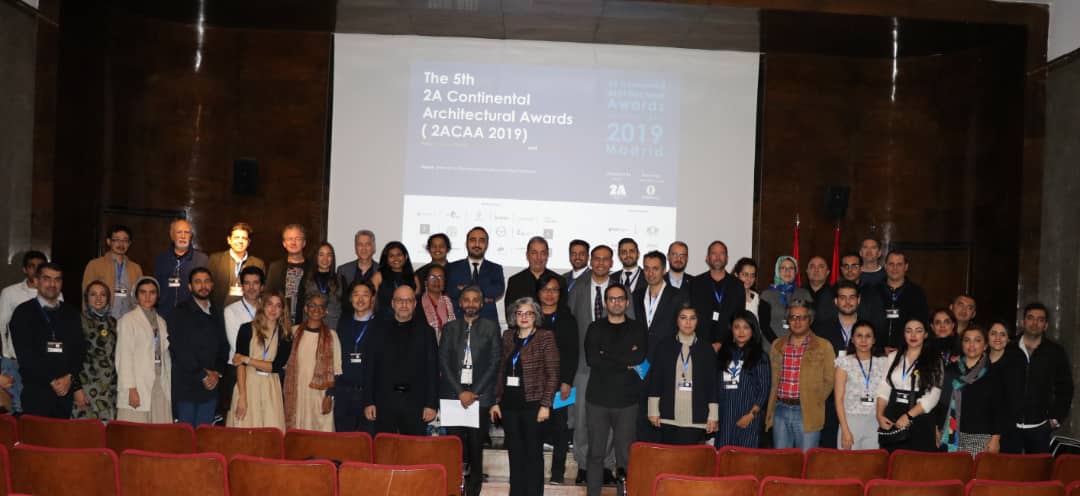
Interaction Forum of 2ACAA 2019
A Forum for International Ineraction and Exchanging the Theories and Practices of Architecture
2A Magazine: In the Interaction Forum of 2ACAA, we strive make people conscious of architectural practices of various typologies from different countries by showcasing their innovative, social, environmental and political impacting their community and context.
At 2ACAA Interaction Forum, Innovative architecture is a crucial part of the topic of the architectural discussion We believe that innovation is the most critical concern in present day architectural planning and design. Innovative architecture is a significant constituent in the Interaction forum’s
2ACAA Interaction Forum:
Expanding the prospects of architectural dialogue
With the 2ACAA Interaction Forum, the 2A Magazine hopes to boost the overall thinking while developing advanced architectural thinking globally.
This event provides the architects an opportunity to make use of their fundamental ways of thinking and expand their sensibilities. Through the interaction during the forum, they can develop new and unusual narratives of the possible. We want prospective Architects to focus on modern architecture as empowerment. We believe that architecture is no longer an affair of form, but instead a matter of what the projects make possible.
Another primary focus of this event is amalgamation of architecture and cultural history. Architecture tells more than a few stories it serves an essential purpose while representing culture, ethnicity and expressing the dynamics of its societal, economic, as well as political fortunes. This architecture communicates through form-making, scale, or context.
model of thinking that strives to meet the same general goal of smarter structural development.
Chitra K. Vishwanath
Moderator of 2A Interaction Forum
and Member of the Jury Board of 2ACAA 2019

2ACAA is a work in progress and it is my privilege to be associated with it. 2ACAA has been having an interaction forum in every event of its award ceremony. The interaction forum is the platform for architects who necessarily need not be either selected here or are award winners to showcase their projects and ideas. This year we are taking a step further here by asking for an abstract based on socio-cultural themes with visions of the future. This exercise allowed us to seek out interesting topics to choose from which resonated with the conceptual framework either as talk of ideas or of pure projects.
We also took the step of limiting the time one takes to present so that the interest to listen is kept and thereby increasing the number of presentations. So for the presentations we have chosen Pecha-Kucha format which is quick and succinct. It also shows the creativity of the presentation to drive home the concept in the most interesting and riveting manner.
In this evolving global citizenship, we are no longer a citizen of a politically constructed boundary but are citizens of a planetary boundary and the actions we take to have effects in long distances. We see 2ACAA interaction forum as a global campfire built around to create a space for conversations. It is a space for seeking ideas – ideas of how through architectural visions contextual challenges have been tackled.
The ideas presented here will invoke a shared memory in future and make us collaborate and create a shared vision of the future.
Participants speaking at
Interaction Forum
Madrid, 2019
Suhasini Ayer
India
” Quest for consilience “

My planning and design practice of 3 decades, addresses developmental issues in a country that is deficit in every resource except human. So, am and will be an active audience to the parade of well meaning and enthusiastic individuals, institutions and nations struggling to address the global crisis of climate, economic inequity and national identity. International agreements and commitments keep getting formulated and signed to stall, reverse and repair the problems with techno-legal tools coupled with incentives and embargos.
To my understanding none of these harness the force of human will and our ability of self-reflection. Even as the last 10,000 years of human settlement history is about exploitation both inter and intra species, human beings are still moved by compassion, tolerance and altruism.
My vision and goal is to address this aspect of humanity through multilayered partnership in planning and designing of settlements, revisiting and questioning old patterns of social hierarchy and its impact on built spaces. Each project is welcomed as opportunity to question the post industrial structure of social –
economical and environmental paradigm, fragmentation for efficiency. We seek to meld the process and product, to find a synthesis with the context – geophysical, socio-cultural, economic and environmental.
Meghdad Sharif
Iran
” Finding Atmosphere “

My interest, is in research and developing practical topics related to intellectual farme -works, with specific focus on design process with ability to sustain timeless theoretical projects. Having in mind the possibility if a new generation of design pedagogy arising from rapid changing life situations, environment, and
technology, this design process could be an elevation force towards a move forward in architecture.
This approach leads us to work on a design process models based on “Space Finding” and “Atmosphere Exploration”.
I would like to apply a fictional cinematic approach to document the process. achieve a practical and imprical model for design process in academic studios and architecture offices. The outcome will bring about a broad range of solutions addressing design models & tools, enabling designers and planners to better empathize with users. The approach of “Space Finding” can empower the role of design in underdeveloped communities.
How we can reach to a design process model that based on new spatial experience in architecture spaces and how with this model of design we can design many kind of experience and many kind of events in public spaces? How we can categorize the atmospheric solutions of spaces and how its improve our design process? Can we create a platform encyclopedia of atmosphere in spaces with the aim of developing that.
Yoshiaki Tanaka
Japan
” Warm Transparency “

Conventionally, a hospital tends to be a space that has poor natural color or material due to artificial structure material to improve the functionally and the efficiency. Therefore, patients feel that they are being apart from their daily life. A consideration for a comfortable environment where patients can spend
and free from stress, should be taken.
We provide an open, comfortable space by setting an L-shaped open ceiling space and the large eaves by using a plenty of wood material.
The large eaves and the L-shaped open ceiling space generate a gradation for the boundary between gradation town and the clinic. They created a comfortable intermediate space in addition to a function as a building space. The L-shaped open ceiling space connects a spaces of the rehabilitation room and the waiting room on the second floor in addition to the outside and the inside of use clinic so that the patients can spend relax, comfortable time as if they are being in a lobby. A plenty of wood material was used for portions touched by people directly for reducing nervousness. This building has “Warm Transparency” for the town.
Mani N’wuitcha
Togo
” THE CONSTELLARIUM “

Education in Africa is commonly faced to a rupture with the traditions of local populations. It’s the reason why people in rural communities often don’t scholarize their children. The system is inadequate with their conditions of living. Most of them live from agriculture.
The site of the project is located in Dogon country, a region in Mali, precisely in the village of Sangha.
This country is chosen, because it is a representative sample of challenges to be faced in the third world countries. The title of the project relates to Dogon people’s rich culture in astronomy, for which they are known.
We imagine a place of harmony where community can spread its culture, and where educational should rhyme with local practices, economic and social participation.
The project objectives include:
• Modularity serving a social approach. Workshops are preferred to standard classrooms. Removable partitions make the workshops modules some gigantic brainstorming areas where students can mix their knowledge or reunite with special guests (Community craftsmen, professionals or even their parents).
All the spaces can be used during class by the children, and after school by the whole community.
• The rebranding of the educational system by teaching the children in a creative and entrepreneurial way, how to create income from the community skills. This approach will change the mindset about the uselessness of school program, according to some parents.
• An ecological aspect through a community involvement in the building process, the use of local material and techniques), the reduction of the carbon footprint and valorization of biologic agriculture.
Jose Alfonso Quinones
Mexico
” Utopia “

Any human labor that considers serving others, necessarily implies a Utopia, a place which we will never reach but allows us to keep moving forward as individuals and as society. Architecture is not the exception; in fact, it represents this in an explicit way.
As architects in order to establish our own utopias, we try to understand the present moment we are living, the zeitgeist and actual paradigms that conditions the way we live, so we can answer with specific spacial responses that may accomplish this purpose, therefore without forgetting the great Utopias that
prevail in human beings as finding beauty and truth in spaces.
Along history a very important need has been the smart use of resources. Today, we have learned that the best answer is the reuse of these resources. 500 years ago, an architect would’ve used the forests he had at hand to build. Nowadays these forests are our cities full of buildings in need to be renovated.
We believe architecture should commit to create a better world and establish new utopias which will never be reached but oblige us to keep working.
Rosie Paul
India
” Architecture beyond Architects “
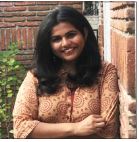
Architecture, the practice and the product are never confined to a single built structure. What we as architects build, creates a ripple effect around it impacting several other realms like the community, the economy and the environment. So in essence, architects of today, have the opportunity and the responsibility to create a positive impact on the environmental, cultural and socio-economic fabric of the society. This responsibility forms an integral part of our mission at Masons Ink Studio which we strive towards through our projects, outreach and capacity building initiatives that cater to all sections of society. A
substantial percentage of the workforce in the construction industry in India compris ed of unskilled labor. We believe architecture can bridge the gap between the existing and required levels of skill and can be a powerful tool in combating poverty. The firm’s underlying philosophy is focused towards empowering the labor force while minimizing the carbon footprint and embodied energy of our projects. This can be understood as we take you through our project Raa Maram (Sanskrit for Beautiful woods), an organic farmhouse situated in Manchi, Tamil Nadu, India. A structure that was built using natural materials by the local labor and community, it was the first step in our endeavor to contribute towards skill development in our country.
Richard De la Riva
Canada
” The City Hall: Designing Democracy “

Affleck de la Riva Architects have had the opportunity to design six recent city hall projects. The story of each of these initiatives provides a portrait of the values of six distinct municipalities and also sheds light on the current architectural debate in Canada. During my presentation, I will describe all six projects in relation to each architectural idea or challenge undertaken. I will then expand on the ideas best exemplified through two of these projects. Requiring rigorous heritage conservation expertise, Saint-Roch City Hall involved the conversion of an historical convent into municipal offices and meeting spaces but also asked the question of what an appropriate addition to the building would be. (We dealt with this addition in a contemporary fashion.) In contrast to Saint-Roch City Hall, Rigaud City Hall is a new building that restructures an historic village centre. This project presents an abstracted version of the classical temple, reinterpreted in contemporary form. How does municipal architecture project an image of democracy, accessibility and transparency to its citizens?
Maarten van Bremen
Metro station renovation in Amsterdam
Innovative architecture as basis for modernisation
Netherlands
” Innovative Architecture as Basis for Modernisation ”
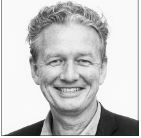
Metro station renovation in Amsterdam Innovative architecture as basis for modernisation
Architecture studio GROUP A recently completed the renovation of the Oostlijn (Eastbound Line) of the Amsterdam Metro. Based on this ten-year project we developed a vision on the importance of innovative architecture for the modernisation of public transport. Our design vision is based on enhancing comfort, security and identity via innovative architecture. The Oostlijn includes 16 stations from Central Station to Amsterdam Zuidoost. It was built in the seventies in a signature brutalist style. Over the years the clarity of the original architecture had become muddled. The line’s original total design faded because of subsequent modifications. In short, the stations were no longer equipped to the future. The aim was to create modern stations which functions adequately, are comprehensibly organized and pleasant to use. We proposed to achieve this without denying the brutalist DNA of the metro line or even demolish it. But instead we build upon it. With a strong and smart design the Metro Oostlijn now fits the heavier use of infrastructure, current regulations and grown user expectations.
Syed Fawad Hussain
Pakistan
” Localized Concepts”
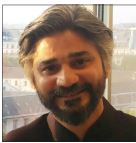
Concept and creation are related to each other. Concepts are how we comprehend the world around us, they help us to deal with everyday life and at the same time, a means to move beyond these everyday experiences and think new possibilities of creation. Concepts must express the state of affairs and relate to the circumstances strongly in which they are produced. That is precisely why they are not conceived a priori and cannot be generalized as we commonly thought about concepts. These particular situations and states of affairs can only be comprehended and expressed through their singularities their unique beingness on a very local level. To distinguish them from the generalized concept of concept we can call them Localized Concepts. Localized Concepts are concentrating on the singularities of the things shift the emphasis from what things are or are called to what things can do. These localized concepts are the sources of the creation of architecture that respond to problems that are particular to the situations/locale and an architecture that is more concerned with the immanent properties of the materials. Localized Concept is not a limiting idea but involves cultural as well as ecological values. It takes care of not only the shifts in the environment around us but also the areas of human thought, feelings and sensibilities.
Saman Motamedi
Iran
” Vernacular Organic Arcitecture “

“Earth || Residential Complex” is planned and designed based on our major strategy “Piecemeal Architecture”. This project has formed, progressively, by adjoining the “spatial concepts of Iranian architecture”- such as interior yard concept, access to the sky and nature-oriented design – with a contemporary approach of fusion, achieved an integration which resulted in a coherent plurality.
This is an expression of “simplicity” along with “aesthetic” values which has been organized according to the idea of “Vernacular Organic Architecture” and as a result, the reality of space will be understood uniform from both inside and outside of the project. Construction the project elements simultaneously; like creating the live skin (not the shell) which not only drives the architecture away from the high costs of the façade making but also presents the outside appearance of the interior space in an excellent method. This characteristic of the “Vernacular Organic Architecture” enables the project to have a live skin; it changes color and appearance in different seasons just like the nature; we can observe its growth through time (in the south facade). Furthermore, this architecture keeps the connection with the nature from the inside which improves the quality of life and gives the opportunity of living along with natural environment in a compact city. Living in a live and organic architectural space is the foundation of reconnecting with the nature and achieving the forgotten comfort and peace in today’s cities.
Sarah Tió
Dominican Republic
” Architectural intervention as a change in the image of the city”

The focus of the presentation and their role in creating urban scenes with a sense of place when no initiatives are taken from municipal authorities and central government in a city of four million people and more than one (1) million cars on track to two million before a decade. A NON WALKABLE CITY DESIGNED FOR CARS WITH NOWHERE TO PUT THEM AND HOW TO TRANSFORM IT. The city has set goals for 2030 with no clue as to how to achieve them; our firm with 6 others are working on eleven projects that will transform urban landscape and create public spaces and infrastructure in the context of a city with no urban planning and focusing on business opportunities as the catalyst for transformation. This would be our topic of discussion through the lens of urban planners with a world view that will open a discussion on where proposals have done right and learning from past experiences and projects.
Antoine Guiraud
France
“A sensitive architecture “

The work of the architectural firm GUIRAUD-MANENC results from a sensitive, research and experimentation approach. Placing people at the heart of architectural design, they explore artisanal know-how and constructive innovations to create technical details charged with meaning and history. They work on economic and energy-saving passive constructions with environmental concepts issued from a synthesis of the available ressources and assets of the site. The decomposition of the buildings in juxtaposed coats plays with the notion of thresholds to blur the limit between the inside and the outside. The envelope goes beyond the simple protective function to become a permeable and meaningful epidermis vibrating with the rhythm of the day, the weather and the seasons. In open connection, the buildings offer glances through the hosted activities to initiate synergies towards an architecture that is the vector of a common project. The constructions are designed and implemented to be easily and economically reversible. The production of the agency is part of an ethical, social and cultural logic to establish relationships between the user and the territory and give rise to manifest architectures opening the way for inhabiting a place.
Benjamin Michel
France
“ the sky, the sun and the sea ”

We are a young team of architects and operate in the south of France. This is a territory where it is difficult to escape the steepness of the slope, the presence of the sky, the sun and the sea. The confrontation of architecture with the landscape is a constant search in our creation. The character of the site is very important in our work, how to find it and put it to use. Each site has a sort of hidden energy, and what the architect can do is discover and review this energy. It becomes the raw material of architectural thinking. The terrace is oriented towards the landscape, the patio protects from pollution, buildings adapt to the topography, born on the ground and rises to the sky. But beyond the great theories, the architect Le Corbusier showed us with his realization of the cabanon in Roquebrune-Cap-Martin, that architecture is above all to allow a poetic lifestyle in relation to the landscape. In front of the sea, it was a minimum habitat where we live mainly outside. The cabanon windows are sized and positioned according to the view on the outside. We take the shower in the shade of a tree, the view on the horizon. A small staircase leads directly to the sea to take a bath. Life is Beautiful.
